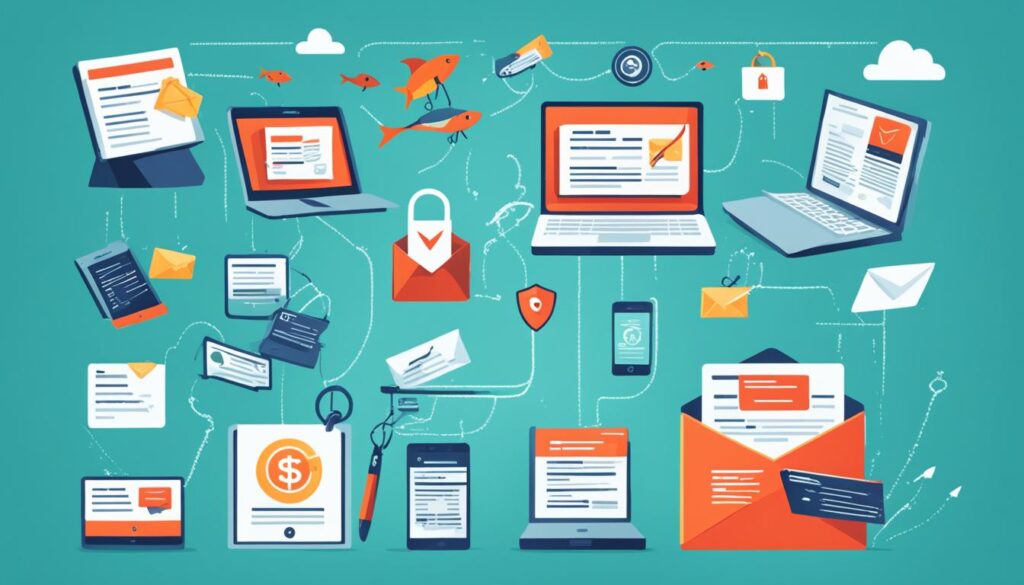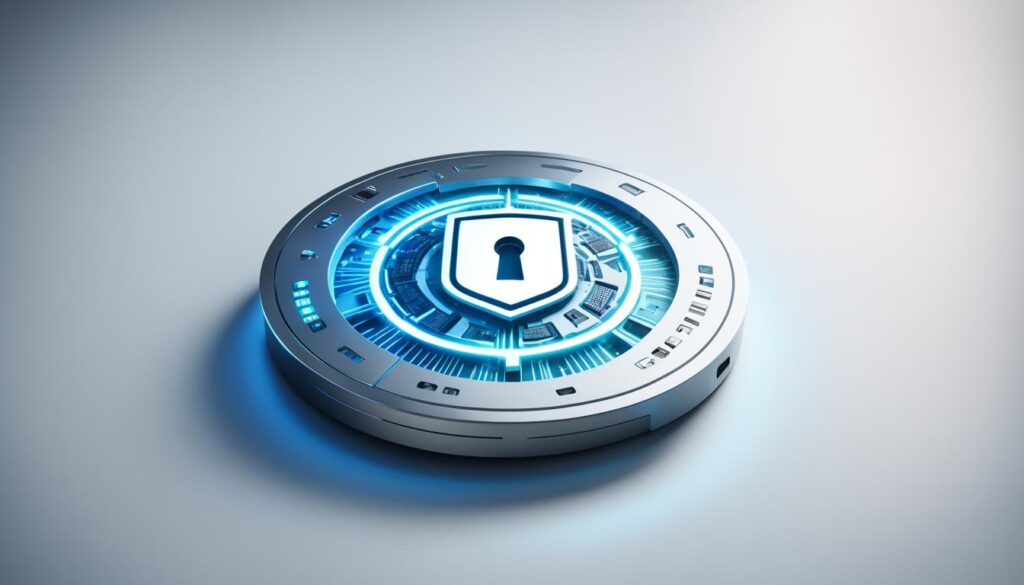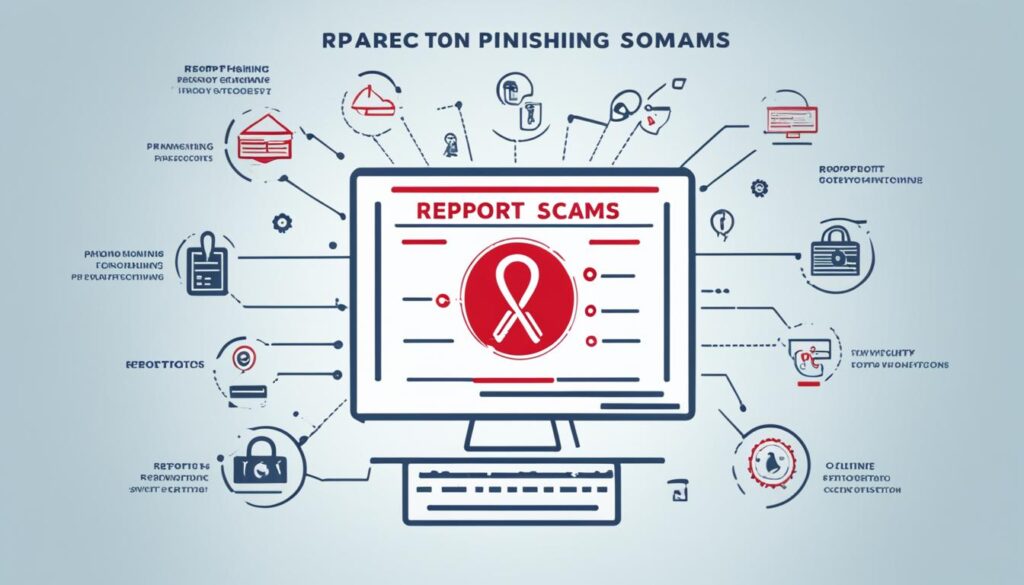An astonishing 74% of organizations in the United States experienced a successful phishing attack in 2021, according to reports from cybersecurity firms. This figure, startlingly above the global average, underscores the critical importance of bolstering your cybersecurity practices against phishing scams. As scammers continually refine their tactics, understanding the nuances of phishing prevention and scam detection becomes expedient for safeguarding personal and organizational assets from online fraud.
But what exactly should you look out for, and how can you actively prevent phishing attacks? This article will furnish you with the skills and tools needed to not only spot these devious schemes but also to thwart them, reinforcing your overall approach to online security.
To steer clear of today’s sophisticated cyber traps, it’s imperative that you refine your ‘phish-spotting’ lenses. Arm yourself with knowledge, hone your vigilance, and dive into the strategies that fortify your defenses against the relentless onslaught of phishing attempts.
Key Takeaways
- Recognize the prevalence of phishing scams and their impact on US organizations.
- Understand that cybersecurity is an ever-evolving battle requiring up-to-date knowledge and practices.
- Learn the importance of scam detection to mitigate the risk of online fraud.
- Gain insight into preventive measures to prevent phishing attacks effectively.
- Embrace the significance of continuous vigilance and awareness for robust phishing prevention.
Understanding Phishing Scams and Their Impact
In today’s digital age, your online security is under constant threat from cyber scams like phishing attacks. These sophisticated schemes are designed to steal your personal information and expose you to identity theft. But by becoming more informed about phishing awareness and recognizing the red flags, you can protect yourself and your organization from falling victim to these fraudulent practices.
The Anatomy of a Phishing Attack
Phishing attacks are a form of email scams that often begin with a seemingly legitimate message sent to your inbox. The sender masquerades as a trusted entity, prompting you to disclose sensitive data, click on links that install malware, or download attachments loaded with threats. It’s crucial to recognize that these messages are the bait, luring you into actions that could severely compromise your identity theft protection.
How Phishing Scams Affect Individuals and Organizations
When individuals fall prey to phishing attacks, the consequences include personal financial loss and, potentially, identity theft. For businesses, the infiltration can go deeper, causing a breach of confidential data, resulting in substantial financial losses, and damaging the organization’s reputation. Both scenarios highlight the urgent need for increased phishing awareness and rigorous cybersecurity practices.
Recent Statistics on Phishing Incidents
Phishing scam statistics paint a grim picture of the modern cyber-threat landscape. With an ever-increasing number of phishing episodes reported annually, these numbers not only underscore the growing challenge but also serve as a stark reminder of the sophisticated tactics employed by online fraudsters.
| Year | Phishing Attacks Reported | % Increase from Previous Year |
|---|---|---|
| 2020 | 1.2 Million | 20% |
| 2021 | 1.5 Million | 25% |
| 2022 | 1.7 Million | 13% |
The worrisome trend confirms that phishing attacks are becoming more common and sophisticated, calling for a proactive and defensive posture towards online security.
Being aware is your first line of defense against these cyber scams. Stay vigilant, stay informed, and take active steps to reinforce your defense against these intrusive and costly threats to your online security.
Explore the pivotal role of AI and machine learning in revolutionizing cybersecurity strategies by delving into our comprehensive analysis at Soft Spotlight.
Phishing Techniques: From Deceptive Emails to Fake Websites

As you navigate through the digital world, it’s crucial to familiarize yourself with the common phishing techniques cybercriminals use to orchestrate online scams. Understanding these deceptive strategies, such as email phishing and the creation of fake websites, equips you with the knowledge to safeguard your sensitive data.
Let’s break down some of the most prevalent methods:
- Email Phishing: This well-known approach involves sending emails that appear to come from reputable sources to trick recipients into disclosing personal information or clicking on harmful links. These phishing email examples can look startlingly legitimate.
- Fake Websites: Cybercriminals meticulously craft websites that mimic authentic platforms. These sites are set up to harvest login credentials or financial information from unsuspecting visitors.
Be vigilant for signs like:
- Poor spelling or grammar within the email content.
- URLs that don’t match the legitimate domain of the supposed sender.
- Requests for personal or financial information that come out of the blue.
Here’s a comparative look at some phishing techniques:
| Technique | Telltale Signs | Preventive Action |
|---|---|---|
| Email Phishing | Mismatched email addresses and suspicious attachments | Verify sender details and avoid opening unexpected attachments |
| Website Spoofing | Unfamiliar domain names and poor website design | Check for HTTPS protocol and domain authenticity |
| Spear Phishing | Highly personalized emails that request confidential information | Be cautious of emails that seem too targeted and double-check with the entity directly |
By being aware of these phishing techniques, you can critically assess each interaction and deflect the sophisticated lure of online scams. Remember, if an offer or request for information seems fishy, it probably is. Trust your instincts and take the necessary steps to protect yourself from these digital predators.
Email Phishing vs. Other Types of Phishing Scams
In today’s digital era, the threat landscape of email fraud and cybercrime is not confined to a single avenue. With a deeper understanding of vishing, smishing, spear phishing, whaling, and other targeted attacks, you can strengthen your defense against these nefarious tactics. Here, we compare the various techniques used by cybercriminals to manipulate and deceive their targets, revealing how each method presents unique challenges for individuals and organizations alike.
Comparing Email Phishing to Vishing and Smishing
Email phishing, though prevalent, is just one piece in the complex puzzle of cybercrime strategies. Vishing, or voice phishing, capitalizes on the personal touch of a phone call to trick victims into revealing sensitive information. Smishing, similar in deceit, uses SMS texts to serve its malicious intent. While all three methods aim to exploit human vulnerability, their modes of communication and approaches to invoking trust differ significantly.
- Email Phishing: Cybercriminals send fraudulent emails imitating legitimate businesses to extract personal data.
- Vishing: Attackers make phone calls posing as reputable entities to solicit confidential information directly.
- Smishing: Deceptive SMS texts are sent to coax recipients into clicking malicious links or divulge personal details.
Spear Phishing and Whaling: Targeted Attacks
Targeted attacks such as spear phishing and whaling represent a more sophisticated threat. Unlike broad-stroke tactics, these scams are meticulously constructed with specific individuals or high-value targets in mind.
| Attack Type | Target | Objective | Methodology |
|---|---|---|---|
| Spear Phishing | Individuals | Gather sensitive information | Personalized emails using gathered intelligence about the target |
| Whaling | Executives or High-profile individuals | Major fraud or data breaches | Crafted communication masquerading as critical business issues |
Whaling, in particular, could involve duping a company’s CEO into authorizing significant financial transfers or divulging corporate secrets. Similarly, spear phishing might focus on an individual with access to sensitive areas, aiming to navigate through security layers using the victim’s credentials. The lethal efficacy of these methods lies in their customization—targeted attacks are tailored to their victims, increasing the likelihood of success.

The multi-faceted nature of these scams underscores the importance of vigilant cybersecurity measures tailored to deflect diverse methods. Recognizing the characteristics of vishing, smishing, spear phishing, and whaling is paramount in the proactive stance against the scourge of email fraud and associated cybercrimes.
The Indicators of Phishing Attacks
Staying vigilant against internet scams means keeping an eye out for the telltale signs of phishing. It’s not just about ignoring suspicious emails—it’s about understanding the specific characteristics of phishing attempts to enhance your scam awareness. Below are key red flags that can help you discern legitimate communication from deceitful traps set by cybercriminals.
- Unexpected Urgency: Watch for emails pressing you to act fast. Phishers often create a false sense of urgency to elicit a quick, less cautious response from you.
- Unsolicited Requests for Information: Be wary of unprompted inquiries asking for sensitive information such as passwords, credit card numbers, or Social Security numbers.
- Suspicious Links: Hover over links to check if the URL matches the expected destination. Mismatched or convoluted URLs are a strong indicator of a phishing attempt.
- Attachments from Unknown Sources: Unexpected attachments, especially from people you don’t know or trust, could be harboring malware.
- Intimidation Tactics: Emails that threaten dire consequences for failing to take immediate action are leveraging fear to manipulate recipients.

The battle against phishing is as much about knowledge as it is about taking practical steps to protect yourself. By remaining alert and critically evaluating your online interactions, you can significantly reduce your risk of falling for these nefarious schemes. To help prioritize the threats, consider the following table summarizing key indicators:
| Indicator | What to Look For | Action to Take |
|---|---|---|
| Urgent Requests | Demands for immediate action or response. | Pause and evaluate the request; verify independently. |
| Requests for Confidential Information | Asking for passwords, bank details, or other sensitive data. | Do not respond; contact the entity directly via known channels. |
| Suspicious Links | Links that don’t match legitimate addresses or are hidden. | Do not click; verify the sender’s authenticity. |
| Unknown Attachments | Attachments in unexpected emails, especially with a general subject line. | Avoid opening; run antivirus scans if opened accidentally. |
| Threatening Tone | Language that triggers fear for not adhering to the email’s requests. | Recognize the tactic; maintain a critical stance and verify threats. |
Building your ability to spot phishing scams is an ongoing process. As cybercriminals devise new strategies, your scam awareness must evolve. Remember, if an email or request seems off in any way, trust your instincts, and take steps to confirm its legitimacy before proceeding.
Phishing Scams: How To Spot and Stop Them
As we navigate the digital world, the importance of understanding how to recognize phishing scams cannot be overstated. Phishing scams are a profound threat to our online security, employing deceptive emails and websites to gain access to personal, financial, and sensitive corporate information. To bolster your defenses against these fraudulent activities, let’s explore the hallmarks of such scams and arm you with the knowledge needed for effective phishing scams prevention.
Identifying Suspect Communication
One of the clearest signs of a phishing attempt is suspect communication that often contains various red flags. An email from a suspect source may include a compelling but often false urgent request, prompting you to act swiftly. Such emails often employ disturbing or threatening language to elicit a hasty response, potentially leading to compromised personal data. Be on the lookout for messages with generic greetings, phishing email scams often do not personalize the email, which is a telltale sign of a mass-generated phishing attempt.
Best Practices for Verifying Legitimate Contacts
When in doubt about the legitimacy of a communication, follow best practices to ensure you’re dealing with genuine contacts. Directly reaching out to the organization through a contact number obtained from an official source, rather than the one provided in the suspect communication, can help in verifying authenticity. Applying critical thinking and taking the time to perform this step is pivotal in how to avoid phishing scams.
Additional measures include reviewing the email’s domain name for any slight misspellings that attempt to mimic reputable entities and avoiding any action on unsolicited requests for personal or financial information. Let’s compile examples of what to watch for and how to take precautionary measures with a comparative table:
| Suspect Features | Precautionary Actions |
|---|---|
| Generic greetings (e.g., “Dear user”) | Expect personalized communication; disregard generic openings. |
| Requests for urgent action | Verify urgency by contacting the organization directly. |
| Unfamiliar email senders | Check the official website for legitimate contact information. |
| Mismatched or disguised URLs | Hover over links to preview the actual URL before clicking. |
| Unsolicited requests for information | Never provide sensitive information without confirming the requester’s authenticity. |
Adopt a skeptical eye, and familiarize yourself with phishing scams examples. Knowledge is the most powerful tool in the arsenal against these cyber ploys. Combine this with updated security software and email filtering, and you’ll be well-equipped to navigate the waters of the internet with greater safety.

Preventing Phishing: Enhancing Your Cybersecurity Posture
To arm yourself against the sophisticated world of phishing protection measures, a proactive approach is your best ally. It’s essential to conceive an impenetrable digital fortress, integrating various defenses to shield against ominous cybersecurity threats. Let’s break down the essential bulwarks in your quest to protect against phishing scams.
- Generate strong, unique passwords for all your accounts and never reuse them across different platforms. Yes, they’re harder to remember, but they’re also much tougher to crack!
- Enable multi-factor authentication (MFA) wherever possible, adding an extra layer of security that could turn a phishing attempt into a stalemate for the attacker.
- Remember, your software is only as strong as its latest update. Regularly update systems and software to fix any vulnerabilities that could serve as backdoors for cybercriminals.

Start earning effortlessly! Claim your $3 bonus and monetize your unused data with Honeygain. It’s simple, secure, and smart.
Claim Nowand watch your balance grow! 🍯💸
Every click in your inbox matters. Each one could be the difference between safety and a security breach.
When looking down the sights at the enemy, your arsenal should also include specialized tools—think of them as your digital shield and sword against the devious forces of online scams.
| Cybersecurity Tools | Function | Impact |
|---|---|---|
| Anti-Phishing Toolbars | Automatically detect phishing websites | Prevent accidental access to harmful sites |
| Antivirus Software | Monitor for malicious software and activities | Defend against malware and other exploits |
| Educational Resources | Provide up-to-date information on phishing scam protection | Keep you informed and one step ahead of scammers |
It’s a digital battle out there, and to keep your personal information locked away from prying eyes, it takes more than just a single line of defense. Your online security is a fortress that requires continuous fortification. Equip it, strengthen it, and never let your guard down. Stay informed, stay vigilant, and always be prepared to adapt your strategies against the ever-evolving nature of phishing scams. When it comes to protecting your digital life, complacency is the enemy.
Navigating the Digital Risk Landscape: Understanding the Rise of Cyber Insurance Trends
Email Scams Awareness: Educating Your Team and Family
In a world where cyber scams lurk behind every click, fostering an environment of phishing scam awareness is no longer optional—it’s a must. You play a key role in arming both your work team and family members with the knowledge they need to navigate the treacherous waters of cybersecurity threats. Let’s delve into how that can be achieved through continuous learning and resource availability.

Training Workforce on Cybersecurity Threats
Gone are the days when internet security was a concern for the IT department alone. In today’s interconnected workplace, online phishing techniques are becoming increasingly sophisticated, and everyone is a potential target. Investing in comprehensive training programs to educate employees about cybersecurity threats is essential. Through interactive simulations and real-world examples, your team can develop a keen eye for suspicious emails and learn to respond to potential threats proactively.
Resources for Phishing Awareness Programs
Knowledge is power when it comes to defending against internet security breaches. A wealth of resources for phishing awareness programs are at your disposal, ranging from online courses to informative webinars. These resources typically include guidelines on how to recognize phishing emails, safe browsing habits, and prompt reporting procedures. Emphasizing the importance of these programs can drastically reduce the risk of falling prey to online scams, keeping you and your loved ones safe.
Remember, phishing scam awareness is not a one-time event but an ongoing commitment to safety and vigilance online. By educating and continuously updating your team and family on the ever-evolving tactics of cybercriminals, you create a robust defense against the threats that loom in the digital age.
Phishing Protection Measures: Tools and Techniques
In an online landscape fraught with digital pitfalls, your cybersecurity toolkit is your first line of defense against phishing websites and online threats. Phishing protection and prevention start with the robust implementation of security software. Key elements like advanced email filters and firewalls are essential, creating barriers between your information and malicious actors. When it comes to internet security, considering a secure browser is also a move in the right direction; it acts as a gatekeeper, blocking access to known phishing websites and alerting you to the underground currents of cybersecurity risks.
Regular data backups are another indispensable component of comprehensive phishing prevention measures. Think of backups as the safety net for your digital trapeze act, ensuring that even in the event of a slip—such as a successful phishing attack—you can resume performance without devastating loss. Moreover, entrusting your cybersecurity to a multi-layered approach could be the tightrope technique that keeps your personal and professional life balanced against cyber threats. This layered approach could include:
- Active browser settings that warn against untrusted sites and downloads
- Up-to-date antivirus programs that detect and eliminate potential threats
- Two-factor or multi-factor authentication systems as an extra hurdle for unauthorized access
Staying current with the latest updates in cybersecurity safeguards is akin to keeping your digital reflexes sharp. It ensures you’re ready to dodge phishing attempts that could otherwise lead to compromised data integrity. The consequence of falling prey to these online threats cannot be overstated—a single successful phishing attack can snowball into a catastrophic loss for individuals and organizations alike.

Adopting a vigilant stance and a proactive mindset is your surest path to phishing protection. By understanding that no solution is infallible and staying agile in the face of ever-evolving cyber threats, you stand a better chance of thwarting off digital predators. Remember, in the ever-twisting labyrinth of internet security, knowledge and preparedness are your best compasses.
How to Respond if You Encounter a Phishing Scam
Stumbling upon a phishing scam can be unsettling, but taking swift and decisive action is critical in minimizing any potential harm. It’s imperative to promptly report phishing scams to help combat cyber theft and contribute significantly to scam prevention strategies. Let’s delve into the steps you should take if this situation arises, touching on how to report these nefarious activities and the measures necessary to protect against further phishing fraud.

Steps to Report Phishing Scams
When you detect a phishing attempt, acting quickly can halt cybercriminals in their tracks. Reporting such incidents not only assists in your protection but also aids in safeguarding the community at large from phishing fraud. Here’s what you should do:
- Immediately notify the Federal Trade Commission (FTC) via their website or by phone.
- Contact the Anti-Phishing Working Group by forwarding the phishing email to them.
- Inform the company or organization that the phisher was impersonating, as they may have a vested interest in pursuing the matter further.
- If the phishing scam pertains to your financial information, reach out to your bank or credit card issuer as soon as possible.
Damage Control: What to Do If You’ve Clicked on a Phishing Link
In the event you’ve inadvertently clicked on a phishing link, immediate damage control is vital. Below is a table outlining a concrete plan of action to mitigate the risks and help you regain security control:
| Immediate Action | Following Steps | Long-Term Prevention |
|---|---|---|
| Disconnect from the internet to prevent data transmission to the phisher. | Change your passwords from a different, secure device. | Enroll in continuous monitoring services for any suspicious activity. |
| Perform a complete scan of your device for malware and remove any threats discovered. | Contact your financial institutions to notify them of potential phishing fraud. | Regularly update your devices with the latest security patches. |
| Enable two-factor authentication on all your accounts where possible. | Place a fraud alert on your credit reports to warn creditors of possible identity theft. | Participate in phishing awareness training to enhance your ability to spot scams. |
Remember, knowledge is power when it comes to phishing scams. Stay informed and vigilant to protect yourself and your information from these cyber threats. By understanding how to report phishing scams, acting quickly when you suspect cyber theft, and implementing scam prevention practices, you fortify your defenses against sophisticated phishing fraud and contribute to a safer digital environment.
Discover how blockchain technology is transforming cybersecurity practices, offering robust solutions against digital threats, in our in-depth exploration at Soft Spotlight.
Conclusion
As the digital realm continues to expand, your mindfulness towards cybersecurity becomes more vital than ever. Grasping the mechanisms of phishing scams allows you to fortify your defenses against the invasive techniques of cybercriminals, who tirelessly evolve their strategies to bypass even the most cautious scrutiny. With identity theft and online fraud topping the list of modern threats, a comprehensive understanding and proactive approach can shield you from falling prey to these nefarious schemes.
Continuous education on phishing scam awareness and the latest cybersecurity trends ensures that you are always several steps ahead of potential predators of the web. The responsibility to safeguard both personal and professional spaces from internet fraud rests on your shoulders. Implementing effective phishing scam protection measures, from simple habit changes to advanced software solutions, creates a resilient barrier against the deceptive cybercriminal activities.
Your role in diffusing critical knowledge and precautions amongst peers cannot be understated. Encouraging an environment where everyone is informed and vigilant is the key to mitigating risks and preserving the sanctity of digital information. After all, in the realm of cyber safety, the power of collective awareness and action is your strongest ally against the ever-present specter of online fraud.

